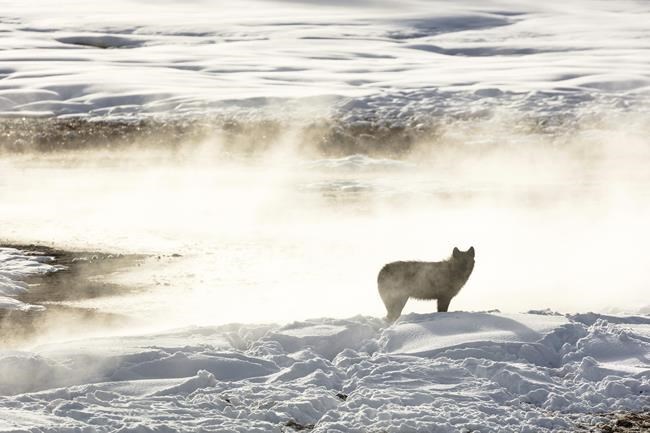
FILE - In this photo released by the National Park Service a wolf from the Wapiti Lake pack is silhouetted by a nearby hot spring in Yellowstone National Park, Wyo., on Jan. 24, 2018. A lawsuit from environmentalists is challenging Montana rules that made it easier to kill wolves in the state, including those that wander out of Yellowstone. (Jacob W. Frank/National Park Service via AP, File)
Republished November 29, 2022 - 4:54 PM
Original Publication Date November 29, 2022 - 4:21 PM
HELENA, Mont. (AP) — A judge on Tuesday lifted a temporary restraining order that limited wolf hunting and trapping in the state, saying there is nothing to suggest rules now in place will make wolf populations unsustainable in the short term.
District Judge Christopher Abbott also rejected concerns raised by environmental groups that harvesting up to six wolves just outside Yellowstone National Park this season could harm the park’s wolf population and conservation efforts.
“We are devastated that the court has allowed countless more wolves — including Yellowstone wolves — to be killed under the unscientific laws and regulations we are challenging,” Lizzy Pennock, the Montana-based carnivore coexistence advocate for WildEarth Guardians said in a statement.
“We will keep fighting for Montana’s wolves in the courtroom while our case carries on and outside the courtroom in every way,” she said.
The decision dissolves a temporary restraining order that Abbott issued on Nov. 16 reducing individual bag limits from 20 to five and blocking the use of snare traps.
The hunting rules set by the Fish, Wildlife and Parks Commission in August take effect immediately, the agency said, including allowing individuals to take up to 10 wolves by hunting and 10 by trapping. The trapping season opened on Monday.
“The state has a legitimate interest in managing wolves... that accounts for all the interests at stake, including those of hunters and ranchers,” Abbott wrote.
Abbott heard testimony Monday in a lawsuit filed by WildEarth Guardians and the Coyote Project, which argued the state changed the method it uses to estimate the wolf population in a way that the groups believe leads to an overestimation. The population estimate informs hunting quotas.
But Abbot said the state's population estimates were not so unreliable that this year’s quota of 456 wolves would trigger irreparable harm.
Montana’s wolf population is estimated at just over 1,100, a number that has remained steady over the past several years, even though 329 wolves were taken in 2021, Abbott noted.
The 2021-22 quota had been set at 450 without any limits set near Yellowstone park. Twenty-three park wolves were killed last winter, including one by Montana Gov. Greg Gianforte.
Officials with the Department of Fish, Wildlife and Parks said Monday the state set this year's quotas based on a law passed by the 2021 legislature that required the Fish and Wildlife Commission to decrease the number of wolves in Montana and to allow trappers to use snare traps.
Idaho is among other states that also loosened wolf-hunting rules at the urging of hunters and ranchers.
As of Tuesday, Montana hunters had killed 69 wolves since the season opened in September.
The dispute over Montana’s wolf hunting season comes as conservationists have pushed for the animals to be restored to more areas, beyond currently occupied wolf habitat in the northern U.S. Rocky Mountains, the Southwest and the western Great Lakes.
The Center for Biological Diversity filed a lawsuit in U.S. District Court in Washington on Tuesday seeking to compel federal officials to draft a national recovery plan for gray wolves that includes potential habitat in West Coast states, the southern Rocky Mountains and the Northeast.
Wolves were exterminated in most of the U.S. by the 1930s under government-sponsored poisoning and trapping campaigns. They were reintroduced from Canada into the northern U.S. Rockies in the 1990s and have rebounded in areas of the Great Lakes.
The mountains and forests of Idaho, Montana and Wyoming have become strongholds for wolf populations since reintroduction, which has helped fuel the species’ expansion in recent years into parts of Oregon, Washington state and California.
The animals were taken off the federal endangered species list in the region in 2011.
Advocates last year petitioned the U.S. Fish and Wildlife Service to restore endangered protections for wolves in the Western U.S. The Biden administration said in a preliminary finding last September that protections for wolves may need to be restored because new laws in Idaho and Montana posed a potential threat to wolves across the region.
News from © The Associated Press, 2022